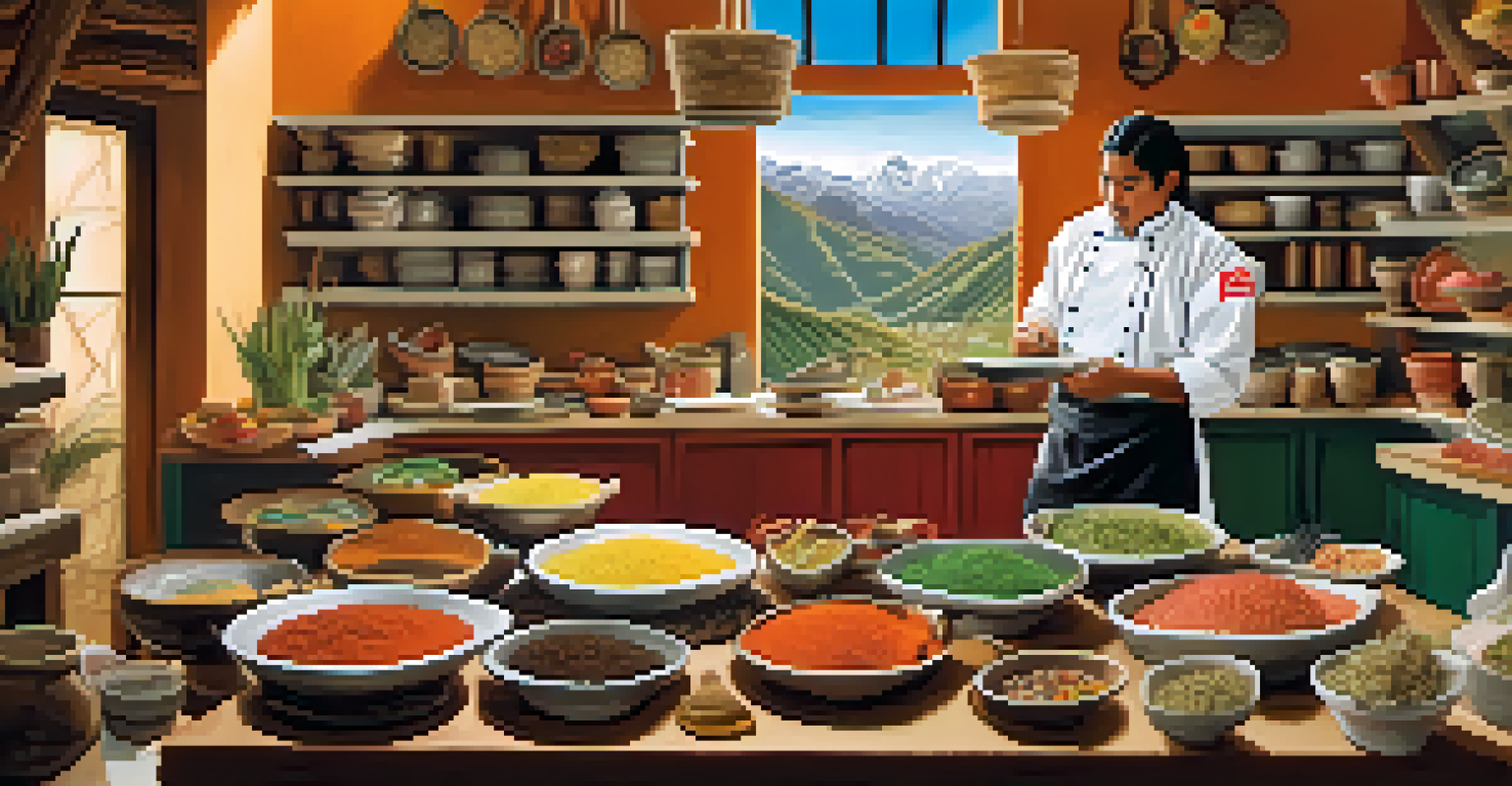The Role of Peru in Latin America's Trade Dynamics

Peru's Strategic Location in Latin America
Peru's geographical position makes it a vital hub for trade in Latin America. Located on the west coast, it borders the Pacific Ocean, facilitating maritime trade with Asia and North America. This strategic advantage allows Peru to serve as a gateway for goods entering and leaving the continent.
Trade is a bridge between cultures, not just a means of economic exchange.
Additionally, its proximity to major economies like Brazil and Chile enhances its role as a trade facilitator. By connecting these diverse markets, Peru plays a crucial part in regional trade agreements and partnerships. This geographical advantage not only boosts its economy but also strengthens regional ties among countries.
Moreover, Peru's varied landscapes and resources provide a wealth of export opportunities, from agricultural products to minerals. This diversity allows the country to cater to different markets, making it a versatile player in Latin America's trade dynamics.
Key Exports and Economic Contributions
Peru is renowned for its rich natural resources, making it one of the largest exporters of copper, gold, and silver. These minerals are essential for various industries worldwide, contributing significantly to the country's GDP. This reliance on natural resources positions Peru as a critical player in global supply chains.

In addition to minerals, Peru is a major exporter of agricultural products like coffee, asparagus, and avocados. The booming agro-export sector has not only created jobs but has also attracted foreign investment, further embedding Peru in global trade networks. This economic diversification helps stabilize the economy against fluctuations in commodity prices.
Peru's Trade Hub Role
Peru's strategic location along the Pacific coast makes it a vital center for trade in Latin America, connecting major economies and enhancing regional partnerships.
Peru's export growth has been supported by several free trade agreements, enhancing its market access. These agreements provide preferential treatment to Peruvian goods, making them more competitive in international markets. As a result, Peru has emerged as a key player in various trade partnerships throughout the region.
The Impact of Trade Agreements
Trade agreements have played a pivotal role in shaping Peru's trade landscape. The Peru-U.S. Trade Promotion Agreement, for instance, has opened doors for Peruvian exports, promoting economic growth and job creation. Such agreements enhance Peru's competitiveness by reducing tariffs and facilitating smoother trade.
Sustainability is not a trend; it's a necessity for the future of trade.
Furthermore, Peru is a member of several regional organizations, including the Pacific Alliance and Mercosur, which foster deeper economic integration. These alliances not only boost trade flows among member countries but also create a larger market for Peruvian goods. By participating in these groups, Peru strengthens its influence in regional trade dynamics.
The government has actively pursued new trade agreements to diversify its partnerships beyond traditional markets. By engaging with countries in Asia and Europe, Peru seeks to reduce its dependency on a few key markets, ensuring long-term economic sustainability. This proactive approach to trade policy makes Peru a dynamic force in Latin America's trade landscape.
Challenges Facing Peru's Trade Sector
Despite its strategic advantages, Peru's trade sector faces several challenges. One significant issue is the reliance on a limited number of exports, particularly minerals. This dependency makes the economy vulnerable to global price fluctuations and can lead to instability.
Infrastructure is another hurdle that affects trade efficiency. Although improvements are being made, many regions still lack the necessary transportation networks to facilitate smooth movement of goods. Addressing these infrastructure gaps is crucial for enhancing Peru's trade capabilities and ensuring sustainable economic growth.
Diverse Export Economy
Rich in natural resources and agricultural products, Peru's diverse export economy bolsters its GDP and reinforces its position in global supply chains.
Additionally, political instability can impact trade relations and investor confidence. Ensuring a stable and transparent political environment is essential for attracting foreign investments and maintaining strong trade partnerships. Overcoming these challenges will be vital for Peru to solidify its role in Latin America's trade dynamics.
Peru's Role in Sustainable Trade Practices
As global awareness of sustainability grows, Peru is increasingly focusing on sustainable trade practices. The country is rich in biodiversity, and there is a push to promote eco-friendly products in international markets. This emphasis on sustainability can enhance Peru's reputation and appeal to environmentally conscious consumers.
Additionally, Peru is working to strengthen its regulations around sustainable mining and agriculture. By adopting responsible practices, the country aims to protect its natural resources while still benefiting economically. This balance is essential for maintaining Peru's role as a key player in regional and global trade.
Moreover, initiatives to promote fair trade and support local communities are gaining traction. By ensuring that producers receive fair compensation, Peru can foster social equity and economic stability, making its trade relationships more sustainable in the long run. This commitment to sustainability not only benefits Peru but also sets a positive example for other countries in the region.
Cultural Exchange Through Trade
Trade is not just about goods; it's also a vehicle for cultural exchange. Peru's unique cultural heritage, from its cuisine to traditional crafts, is increasingly finding its way into international markets. This exchange enriches global culture while also promoting Peruvian identity abroad.
Moreover, as trade relations strengthen, people-to-people connections are formed. These connections can lead to increased tourism and investment, further boosting the economy. For instance, international interest in Peruvian cuisine has led to a surge in culinary tourism, showcasing the country's rich flavors and traditions.
Focus on Sustainability
Peru is increasingly prioritizing sustainable trade practices, promoting eco-friendly products and fair trade to enhance its global market appeal.
Cultural exchange through trade fosters mutual understanding and respect among nations. As Peru continues to engage with the global market, it has the opportunity to highlight its cultural contributions while benefiting economically. This dual impact enhances Peru's standing in Latin America's trade dynamics.
Future Prospects for Peru's Trade Dynamics
Looking ahead, Peru's trade dynamics are set to evolve, influenced by global trends and regional partnerships. The ongoing transition towards digital trade presents new opportunities for Peruvian businesses to reach international markets. By adopting e-commerce strategies, Peru can tap into a growing online consumer base.
Additionally, the demand for sustainable and ethically sourced products is likely to shape future trade policies. Peru's commitment to sustainable practices positions it well to meet this demand, potentially opening new markets for its products. As consumers increasingly prioritize sustainability, Peru can leverage its natural resources responsibly.

Finally, strengthening relationships with emerging economies will be crucial for Peru’s trade future. By diversifying its trade partnerships and exploring new markets, Peru can enhance its resilience against global economic fluctuations. This strategic approach will ensure that Peru remains a vital player in Latin America's trade dynamics.